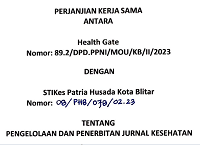Relationship between Frequency of Urinary Catheter Care and Incidence of Urinary Tract Infection
Abstract
Urinary tract infection (UTI) is a frequent occurrence in hospitals and it was reported that 37% of inpatients at RSU Muhammadiyah Ponorogo were fitted with urinary catheters and 38% of them experienced UTI. Frequency of urinary catheter care could potentially affect the incidence of UTI. This study aims to determine the relationship between the frequency of urinary catheter care and the incidence of urinary tract infection (UTI) in the KH Ahmad Dahlan Room of RSU Muhammadiyah Ponorogo. This research method is quantitative with a correlational design using a Cross Sectional approach. The study population was all inpatients in the KH Ahmad Dahlan Room at RSU Muhammadiyah Ponorogo in September - October 2023 totaling 484 patients with an average of 242 people / month. The sampling technique used purposive sampling with the research sample being a portion of inpatients with catheters installed, totaling 30 respondents. Data collection using Check List. Data analysis techniques using Chi-Square. The results of this study showed that of the 30 respondents, most of the 28 respondents (93.33%) with the frequency of urinary catheter care were irregular (not every day) and most of the 29 respondents (96.67%) experienced the incidence of urinary tract infections (UTI). The results of the Chi-Square statistical test obtained a p-value obtained of 0.095> 0.05 so as not to reject H0 which means there is no significant relationship between the frequency of urinary catheter care and the incidence of urinary tract infection (UTI).
Full Text:
PDFReferences
1. Mantu FN., Ranti GL, Widdhi B. EValuasi Penggunaan Antibiotik Pada Pasien Infeksi Saluran Kemih di Instalasi Rawat Inap RSUP. Prof. Dr. R. D. Kandou Manado Periode Juli 2013 - Juni 2014. PHARMACON J Ilm Farm. 2015;4(4). https://doi.org/10.35790/ebm.v1i1.4605
Kementerian Kesehatan RI. Profil Kesehatan Indonesia 2014.; 2015.
Chenoweth CE, Gould C V., Saint S. Diagnosis, management, and prevention of catheter-associated urinary tract infections. Infect Dis Clin North Am. 2014;28(1):105-119. https://doi.org/10.1016/j.idc.2013.09.002
Loveday HP, Wilson JA, Pratt RJ, et al. epic3: National Evidence-Based Guidelines for Preventing Healthcare-Associated Infections in NHS Hospitals in England. J Hosp Infect. 2014;86(S1):S1-S70. doi:10.1016/S0195-6701(13)60012-2
Banks H, Abdella R, Willmann Y. Nursing Interventions Aimed at Reducing the Incidence of Hospital Acquired Catheter-Associated Urinary Tract Infections. Published online 2016. DOI: 10.1097/01.WON.0000347655.56851.04
Lee H, Lee YS, Jeong R, Kim YJ, Ahn S. Predictive factors of bacteremia in patients with febrile urinary tract infection: An experience at a tertiary care center. Infection. 2014;42(4):669-674. https://doi.org/10.1007/s15010-014-0615-3
Wijayanti D. Surveilans HAIs: Kejadian Infeksi Saluran Kemih (SK) di RSUD Panembahan Senopati Bantul. Published online July 30, 2013.
Irawan E, Mulyana DH. Faktor-Faktor Penyebab Infeksi Saluran Kemih (Isk)(Literature Review). Pros Semin Nas dan Penelit Kesehat 2018. 2018;1(1):978-602. Accessed July 4, 2024. https://ejurnal.universitas-bth.ac.id/index.php/P3M_PSNDPK/article/view/353
Kesehatan M. Permenkes No 27 Tahun 2017. Occup Med (Chic Ill). 2017;53(4):130.
Sumolang SAC, Porotu’o J, Soeliongan S. Pola Bakteri Pada Penderita Infeksi Saluran Kemih Di Blu Rsup Prof. Dr. R. D. Kandou Manado. Accessed July 4, 2024.
https://doi.org/10.35790/ebm.v1i1.4605
Peraturan Presiden RI No 12 Tahun 2013. Vol 1.; 2013:شماره 8; ص 99-117. http://www.eldis.org/vfile/upload/1/document/0708/DOC23587.pdf%0Ahttp://socserv2.socsci.mcmaster.ca/~econ/ugcm/3ll3/michels/polipart.pdf%0Ahttps://www.theatlantic.com/magazine/archive/1994/02/the-coming-anarchy/304670/%0Ahttps://scholar.google.it/scholar?
Kementerian Kesehatan RI. Pedoman Manajerial Infeksi Di Rumah Fasilitas Pelayanan Kesehatan Lainnya.; 2011. https://d1wqtxts1xzle7.cloudfront.net/50830994/Pedoman_Manajerial_PPI_2011.pdf?1481467582=&response-content-disposition=inline%3B+filename%3DPedoman_Manajerial_PPI_2011.pdf&Expires=1616856550&Signature=Vo1HaieL4zLxa4gXcEA7UqMBjhgErPzt8dmukpokEG1-o4plP2H-h
DOI: https://doi.org/10.70111/hg2302
Refbacks
- There are currently no refbacks.
"Health Gate"
ISSN 2986-1098
Indexing:
Published by The Regional Leadership Council of the Indonesian National Nurses Association, Blitar City
Kalimantan Street, Kel.Karangtengah, Kec. Sananwetan, Blitar City, East Java, Indonesia


.png)








